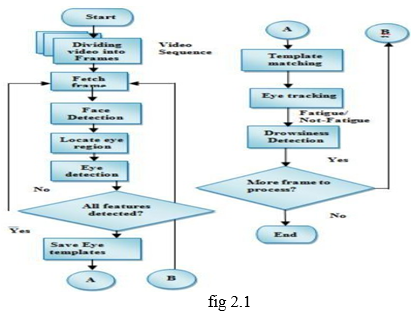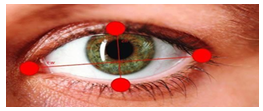Ijraset Journal For Research in Applied Science and Engineering Technology
- Home / Ijraset
- On This Page
- Abstract
- Introduction
- Conclusion
- References
- Copyright
Driver Drowsiness Detection Using Machine Learning
Authors: Prof. Swati Gade, Kshitija Kamble, Aishwarya Sheth, Sakshi Patil, Siddhi Potdar
DOI Link: https://doi.org/10.22214/ijraset.2022.40895
Certificate: View Certificate
Abstract
This document is a review report on the research conducted and the project made in the field of computer engineering to develop a system for driver drowsiness detection to prevent accidents from happening because of driver fatigue and sleeping. The report proposed the results and solutions on the limited implementation of the various techniques that are introduced in the project. Whereas the implementation of the project gives the real world idea of how the system works and what changes can be done in order to improve the utility of the overall system. Furthermore, the paper states the overall of the observation made by the authors in order to help further optimization in the mentioned field to achieve the utility at a better efficiency for a safer road.
Introduction
I. INTRODUCTION
Humans have always invented machines and devised techniques to ease and protect their lives, for mundane activities like traveling to work, or for more interesting purposes like aircraft travel. With the advancement in technology, modes of transportation kept on advancing and our dependency on it started increasing exponentially. It has greatly affected our lives as we know it. Now, we can travel to places at a pace that even our grandparents wouldn’t have thought possible. In modern times, almost everyone in this world uses some sort of transportation every day. Some people are rich enough to have their own vehicles while others use public transportation. However, there are some rules and codes of conduct for those who drive irrespective of their social status.
One of them is staying alert and active while driving. Neglecting our duties towards safer travel has enabled hundreds of thousands of tragedies to get associated with this wonderful invention every year. It may seem like a trivial thing to most folks but following rules and regulations on the road is of utmost importance. While on road, an automobile wields the most power and in irresponsible hands, it can be destructive and sometimes, that carelessness can harm lives even of the people on the road. One kind of carelessness is not admitting when we are too tired to drive. In order to monitor and prevent a destructive outcome from such negligence, many researchers have written research papers on driver drowsiness detection systems. But at times, some of the points and observations made by the system are not accurate enough. Hence, to provide data and another perspective on the problem at hand, in order to improve their implementations and to further optimize the solution, this project has been done.
A. Motivation
Now-a-days, there is huge increase
in private transportation day by day in this modernize world. It will be tedious and bored for driving when it is for long time distance. One of the main causes behind the driver’s lack of alertness is due to long time travelling without sleep and rest. Tired driver can get drowsy while driving.
Every fraction of seconds drowsiness can turn into dangerous and life- threatening accidents may lead to death also. To prevent this type of incidents, it is required to monitor driver’s alertness continuously and when it detects drowsiness, the driver should be alerted. Through this we can reduce significant number of accidents and can savelives of people.
II. LITERATURE SURVEY
A. System Review
This survey is done to comprehend the need and prerequisite of the general population, and to do as such, we went through different sites and applications and looked for the fundamental data. Based on these data, we made an audit that helped us get new thoughts and make different arrangements for our task. We reached the decision thatthere is a need of such application and felt that there is a decent extent of progress in this field too.
B. Technology Used
- Python: Python is an interpreted, high-level, general- purpose programming language. Python's design philosophy emphasizes code readability with its notable use of significant whitespace. Its language constructs and object-oriented approach aim to help programmers write clear, logical code for small and large-scale projects. Python is dynamically typed and supports multiple programming paradigms, including procedural, object- oriented, and functional programming.
- JUPYTER Lab: Project JUPYTER is a nonprofit organization created to develop open-source software, open-standards, and services for interactive computing across dozens of programming languages.
- Image Processing: In computer science, digital image processing in the use of computer algorithms to perform image processing on digital images.
- Machine Learning: Machine learning is the scientific study of algorithms and statistical models that computer systems use in order to perform a specific task effectively without using explicit instructions, relying on patterns and inference instead. It is seen as a subset of artifical intelligence. Machine learning algorithms build a mathematical model based on sample data, known as "training data", in order to make predictions or decisions without being explicitly told. image processing is the use of computer algorithms to perform image processing on digital images.
C. Proposed System
Face and Eye Detection open cv algorithm
In this paper a novel approach to critical parts of face detection problems is given, based on analogic cellular neural network (OpenCV) algorithms. The proposed Open CV algorithms find and help to normalize human faces is, effectively while cause for most accident related to the vehicles crashes. Driver fatigue their time requirement is a fraction of the previously used methods.The algorithm starts with the detection of heads on colour pictures using deviations in colour and structure of the human face and that of the background.By normalizing the distance and position of the reference points, all faces should be transformed into the same size and position.For normalization, eyes serve as point reference. Other OpenCV algorithm finds the eyes on any grayscale image by searching characteristic is features of the eyes and eye sockets. Tests made on a standard database show that the algorithm works very fast and it is reliable.In proposed method, first the image is acquired by the webcam for processing. The images of the driver are captured from the camera which is installed in front of the driver on the car dashboard. It will be passed to preprocessing which prepares the image for further processing by the system. Its main operations are to eliminate noises caused by the image acquisition subsystem and image enhancement using Histogram Equalization. Then we search and detect the faces in each individual frame. If no face is detected then another frame is acquired. If a face is detected, then a region of interest in marked within the face. This region of interest contains the eyes. Defining a region of interest significantly reduces the computational requirements of the system. After that the eyes are detected from the region of interest. If an eye is detected then there is no blink and the blink counter is set to „20?. If the eyes are closed in a particular frame, then the blink counter is decremented and a blink is detected. When the eyes are closed for more than 4 frames then it is deducible that the driver is feeling drowsy. Hence drowsiness is detected and an alarm sounded. After that the whole process is repeated as long as the driver is driving the car. The overall flowchart for drowsiness detection system is shown in Figure 2.1

III. SOFTWARE REQUIREMENTS SPECIFICATION
A. Project Scope
In the project, the main focused will be based on:
- Concept of drowsiness detection system.
- Determine drowsiness from these parameters: a) Blink eye. b) Eye of Ratio (EAR).
- Coding development and testing.
- Complete testing and improvement
B. Functional Requirements
A functional prerequisite is described as one portion or an element of a product, in the entire methodology of programming building. A capacity or part is also depicted as the lead of a section and its yields, given a great deal of data source. A useful perquisite may be the figuring identified with specialized and subtitles or data controland getting ready or whatever other express usefulness that describes the target of a particular structure uses the useful necessities are found being utilized cases.
- Recording the drivers steering behavior the moment the trip begins.
- Then recognizes changes over the course of long trips.
-
Determines the drivers level of fatigue.
C. Nonfunctional Requirements
- Image processing is done using the captured video.
- Image is stored in a library called OpenCV.
- Stored image undergo various algorithm and detects if the driver is fatigue and if fatigue raises an alarm.
D. System Requirements
Software Requirements Specification
Python: Python 3.6 and higher version
Libraries
Numpy, Scipy , Playsound, Dlib, Imutils, opencv, etc.
Operating System
Windows or Ubuntu
E. Hardware Requirements
Processor: 64 bit, quad-core, 2.5 GHz minimum per core
- RAM: 4 GB or more.
- HDD: 20 GB of available space or more.
- Display: Dual XGA (1024 x 768) or higher resolution monitors.
- Camera: A detachable webcam.
- Keyboard: A standard keyboard
F. System Implementation
After passing our video feed to the dlib frame by frame, we are able to detect left eye and right eye features of the face.
Now, we drew contours around it using Open CV.
Using Scipy’s Euclidean function, we calculated sum of both eyes’ aspect ratio which is the sum of 2 distinct vertical distances between the eyelids divided by its horizontal distance.

Now we check if the aspect ratio value is less than 0.25 (0.25was chosen as a base case after some tests). If it is less an alarm is sounded and user is warned.
IV. OTHER SPECIFICATION
A. Advantages
Security of vehicle,Record driving data, collision data, position data.
Analyze the accidents in details.
Detect if the driver drunk or not detect if the driver feeling sleepy
B. Limitations
With 80% accuracy, it is obvious that there are limitations to the system. The most significant limitation is that it will not work with people who have very dark skin. This is apparent, since the core of the algorithm behind the system is based on binarization. For dark skinned people, binarization doesn’t work.
Another limitation is that there cannot be any reflective objects behind the driver. The more uniform the background is, the more robust the system becomes. For testing purposing, a black sheet was put up behind the subject to eliminate this problem.
For testing, rapid head movement was not allowed. This may be acceptable, since it can be equivalent to simulating a tired driver. For small head movements, the system rarely loses track of the eyes. When the head is turned too much sideways there were some falsealarms.
The system has problems when the person is wearing eyeglasses. Localizing the eyes is not a problem, but determining whether the eyes are opened or closed.
C. Application
- Transportation business where almost daily accidents occur due to driver fatigue.
- Security guard cabins.
- Operators at nuclear power plants where continuous monitoring is necessary
- Military applications where high intensity monitoring of soldier is needed.
- In classrooms where students feel drowsy and inattentive during the class.
D. Future Work
Currently there is not adjustment in zoom or direction of the camera during operation. Future work may be to automatically zoom in on the eyes once they are localized. This would avoid the trade-off between having a wide field of view in order to locate the eyes,and a narrow view in order to detect fatigue. This system only looks at the number of consecutive frames where the eyes are closed. At that point it may be too late to issue thewarning. By studying eye movement patterns, it is possible to find a method to generate the warning sooner. Using 3D images is another possibility in finding the eyes. The eyes are the deepest part of a 3D image, and this maybe a more robust way of localizing the eyes. Adaptive binarization is an addition that can help make the system more robust. This may also eliminate the need for the noise removal function, cutting down the computations
V. ACKNOWLEDGMENT
Firstly, we would like to express our sincere gratitude to our project supervisor Prof. Swati Gade continuous support of this project and his patient guidance, enthusiastic encouragement and useful critiques, motivation, and immense knowledge. We would like to thank the rest of our thesis committee, Prof. Swati Gade for their guidance helped, insightful comments and encouragement, also for the hard question which incited me to widen my research from various perspectives. Our sincere thanks also go to all the staff members of the department for the valuable information provided by them in their respective fields. We are grateful for their cooperation during the period of our project. Finally, we would like to thank our family for supporting us spiritually during working on the project and our friends who gave us moral support and encouragement throughout the project study
Conclusion
It completely meets the objectives and requirements of the system. The framework has achieved an unfaltering state where all the bugs have been disposed of. The framework cognizant clients who are familiar with the framework and comprehend it\'s focal points and the fact that it takes care of the issue of stressing out for individuals having fatigue- related issues to inform them about the drowsiness level while driving.
References
[1] Computationally Efficient Face Detection; B. Schlkopf-A. Blake,S. Romdhani, And P. Torr. [2] Use Of The Hough Transformation To Detect Lines And Curves In Picture; R. Duda And P. E. Hart. [3] Jain, “Face Detection In Color Images; R. L. Hsu, M. Abdelmottaleb, And A. K. Jain. [4] Open/Closed Eye Analysis For Drowsiness Detection; P.R.Tabrizi And R. A. Zoroofi. [5] Http://Ncrb.Gov.In/Statpublications/Adsi/Adsi2015/Chapter1a%20traffic %20accidents.Pdf [6] Http://Www.Jotr.In/Text.Asp?2013/6/1/1/118718 [7] Http://Dlib.Net/Face_Landmark_Detection_Ex.Cpp.Html
Copyright
Copyright © 2022 Prof. Swati Gade, Kshitija Kamble, Aishwarya Sheth, Sakshi Patil, Siddhi Potdar. This is an open access article distributed under the Creative Commons Attribution License, which permits unrestricted use, distribution, and reproduction in any medium, provided the original work is properly cited.

Download Paper
Paper Id : IJRASET40895
Publish Date : 2022-03-21
ISSN : 2321-9653
Publisher Name : IJRASET
DOI Link : Click Here
 Submit Paper Online
Submit Paper Online

